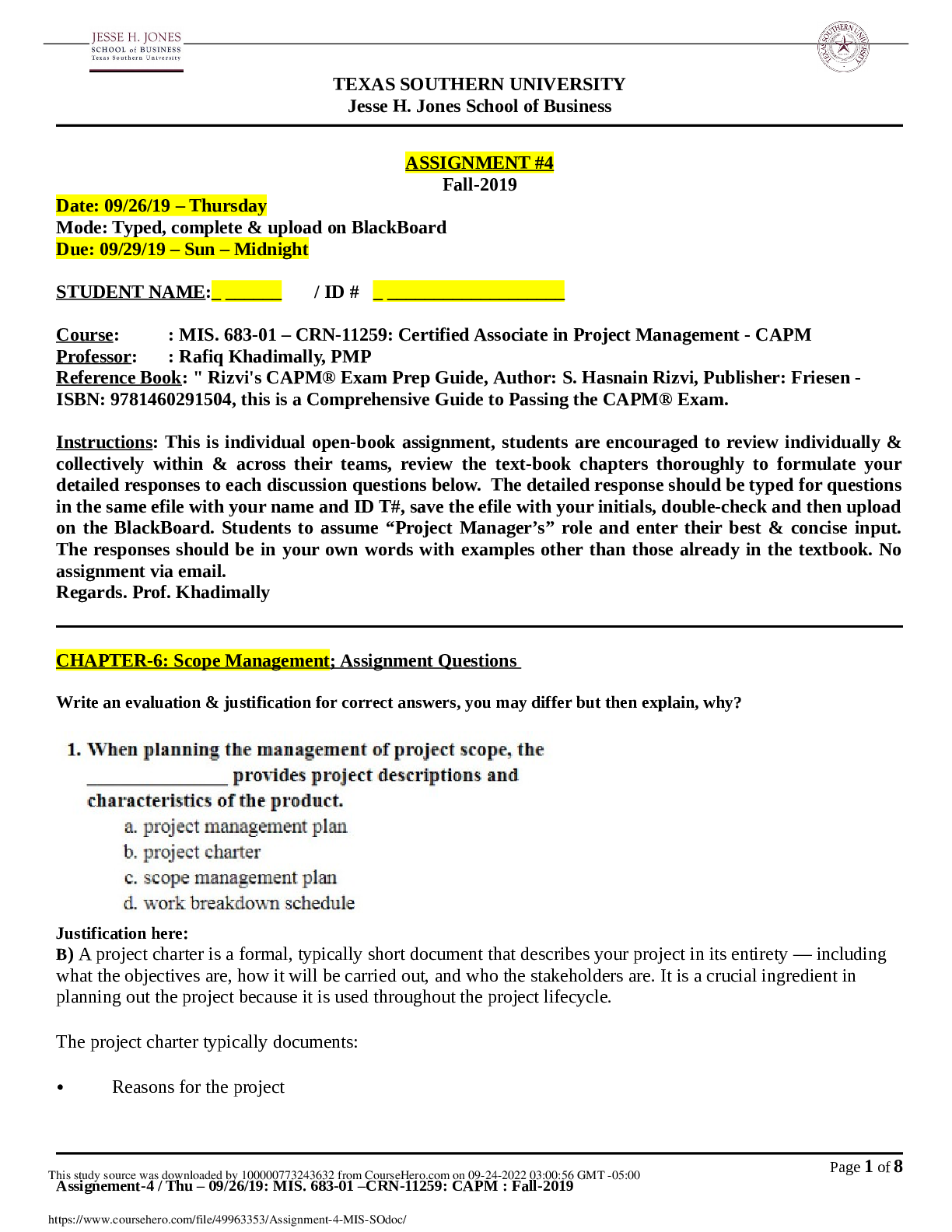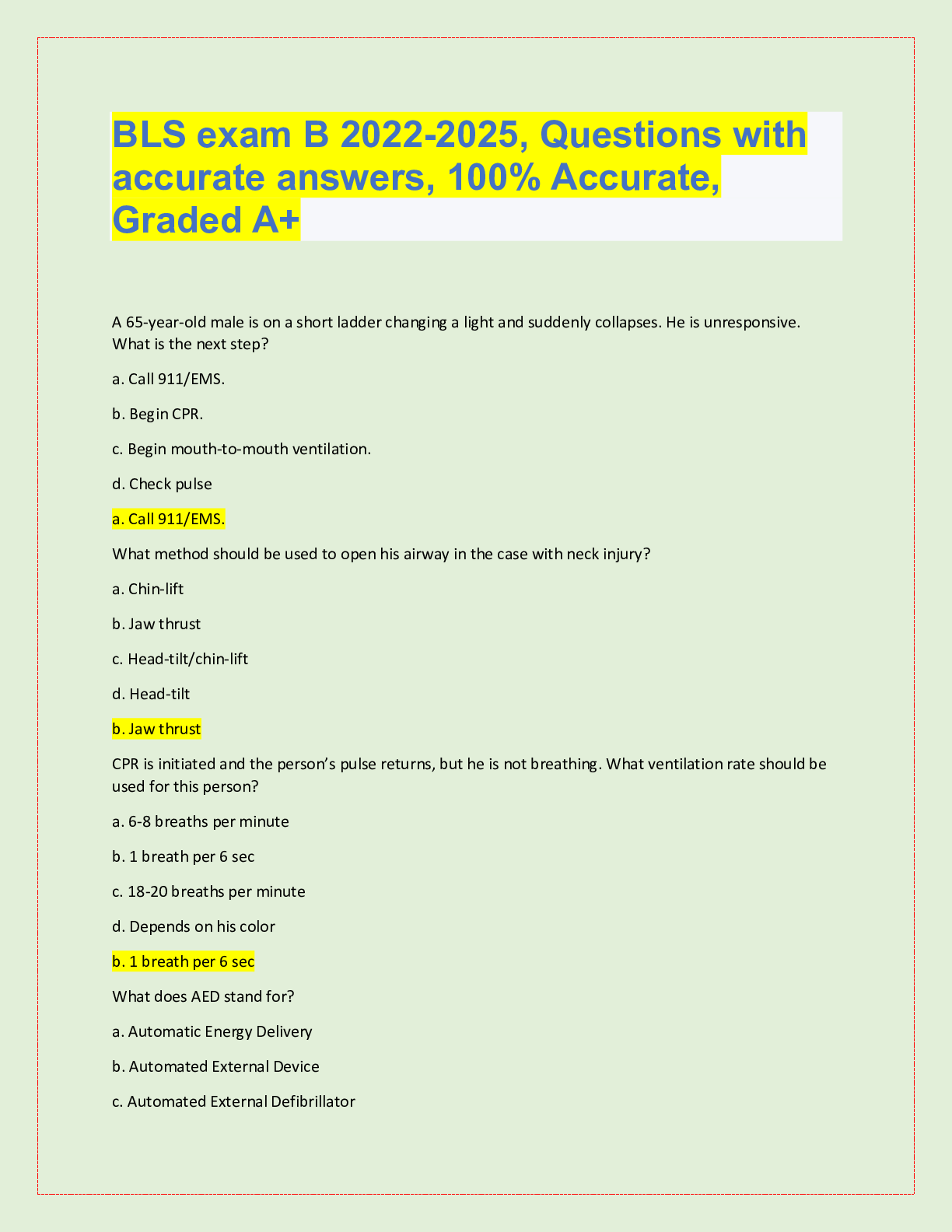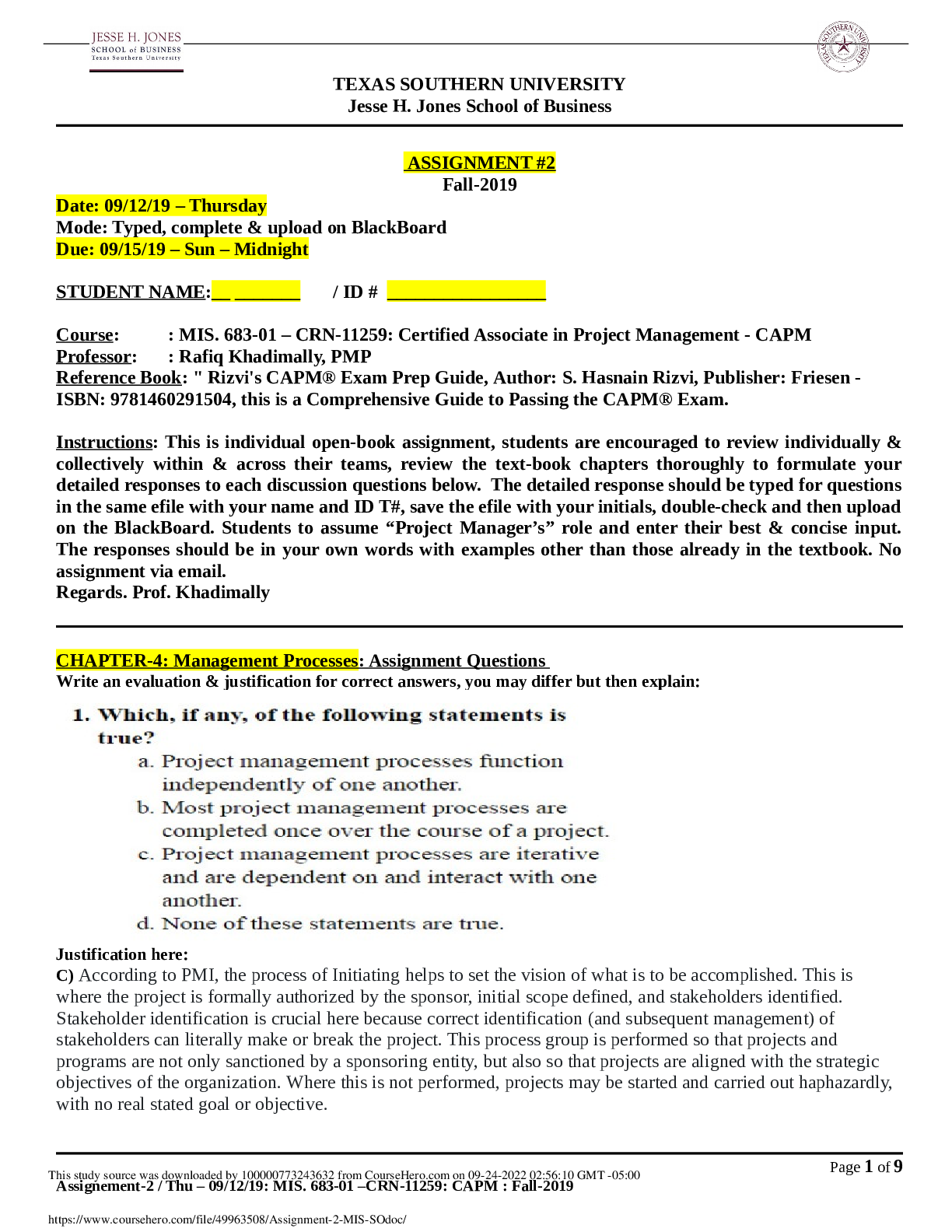Finance > QUESTIONS & ANSWERS > TEXAS SOUTHERN UNIVERSITY Jesse H. Jones School of Business, Rated A (All)
TEXAS SOUTHERN UNIVERSITY Jesse H. Jones School of Business, Rated A
Document Content and Description Below
Write an evaluation & justification for correct answers, you may differ but then explain, why? when planning the management of project scope, ------ provides the descriptions and characteristics of ... the product. Justification here: B) A project charter is a formal, typically short document that describes your project in its entirety — including what the objectives are, how it will be carried out, and who the stakeholders are. It is a crucial ingredient in planning out the project because it is used throughout the project lifecycle. The project charter typically documents: Reasons for the project Page 1 of 8 Assignement-4 / Thu – 09/26/19: MIS. 683-01 –CRN-11259: CAPM : Fall-2019 This study source was downloaded by 100000773243632 from CourseHero.com on 09-24-2022 03:00:56 GMT -05:00 https://www.coursehero.com/file/49963353/Assignment-4-MIS-SOdoc/ TEXAS SOUTHERN UNIVERSITY Jesse H. Jones School of Business Objectives and constraints of the project Who the main stakeholders are? Risks identified Benefits of the project General overview of the budget https://www.wrike.com/project-management-guide/faq/what-is-a-project-charter-in-project-management/ How to Create a Project Charter 1. Understand project goals and objectives. Identify the project vision and determine the scope of the project 2. Define project organization. List all of the essential roles for the project, including customers, stakeholders, and day-to-day project team. 3. Create an implementation plan. Outline major milestones, dependencies and timeline for the entire team and stakeholders. 4. List potential problem areas. No one wants to be a downer but adding potential risks and issues to the project charter helps everyone think ahead should the worst happen. https://www.wrike.com/project-management-guide/faq/what-is-a-project-charter-in-project-management/ Justification here : D) Collect Requirements is the process of determining, documenting, and managing stakeholder needs and requirements to meet project objectives. The key benefit of this process is that it provides the basis for defining and managing the project scope including product scope. There are some set of tools and techniques to gather project requirements. It seems practical to collect all requirements at the start using a requirement-gathering tool. This should ensure the project deliverable as sought. But in reality, it is more challenging in present scenario – Why? The reason is, today’s scenario is dynamic in nature. Needs and requirements of project stakeholders change frequently. So, it's a responsibility of Project-manager (PM) to ensure capturing all the requirements. PM needs to be very agile while collecting requirements. To do so, PM should use appropriate Page 2 of 8 Assignement-4 / Thu – 09/26/19: MIS. 683-01 –CRN-11259: CAPM : Fall-2019 This study source was downloaded by 100000773243632 from CourseHero.com on 09-24-2022 03:00:56 GMT -05:00 https://www.coursehero.com/file/49963353/Assignment-4-MIS-SOdoc/ TEXAS SOUTHERN UNIVERSITY Jesse H. Jones School of Business requirement gathering tools during the project life. PM needs to be wise in the selection of the requirements tools. PM would ensure not to miss any requirement in the project outcome. Because, in the end, PM is liable for the success of the project. https://www.greycampus.com/blog/project-management/project-management-how-to-collectrequirements-for-your-project-effectively Justification here : A) A business requirements document describes the business solution for a project (i.e., what a new or updated product should do), including the user’s needs and expectations, the purpose behind this solution, and any high-level constraints that could impact a successful deployment. Essentially, a BRD acts as the guideline for stakeholders to make decisions regarding project priorities, design, and structure to ensure the project remains aligned with the overall goals of the business. It also represents a basic contract between the customer and the vendor outlining the expectations and deliverables for the project. The BRD sets the standards for determining when a project has reached a successful completion. https://www.lucidchart.com/blog/tips-for-a-perfect-business-requirements-document Justification here: c) When it comes to Project Management, usually there are multiple stakeholders expecting different outputs from the project life-cycle. Therefore, it’s necessary to implement proper group-decision making techniques and methods. Especially this is important when different opinions clash and make conflicts with each other. In addition, these techniques / method may align with group creativity techniques when it’s required. (prior to the execution of group decision-making techniques) According to PMBOK (5th Edition), there are 4 different group decision-making techniques that can be applied throughout the entire project life-cycle. They are as follows; Page 3 of 8 Assignement-4 / Thu – 09/26/19: MIS. 683-01 –CRN-11259: CAPM : Fall-2019 This study source was downloaded by 100000773243632 from CourseHero.com on 09-24-2022 03:00:56 GMT -05:00 https://www.coursehero.com/file/49963353/Assignment-4-MIS-SOdoc/ TEXAS SOUTHERN UNIVERSITY Jesse H. Jones School of Business Unanimity This decision making is defined when everyone participating in the decision-making process agrees on a single course of action. There are few methods that can be followed to achieve this. (E.g.: Delphi technique where group of experts respond to the questionnaire anonymously) Apart from that, this method is known to provide the least hassles on project management team in terms of implementing decision making techniques. Majority Majority relies on most number of votes towards a particular decision. (more than 50%) In order to make this technique more efficient, it’s recommended to have an uneven number of people in the decision making panel to avoid resulting in a tied decision. Plurality This is a bit of complicated decision making technique and more challenging to understand. According to PMBOK (5th Edition), it is a decision reached by the largest block in a decision making panel though it’s not achieved the majority concept. This method is used when the nominated options are greater than 2, hence the option voted by the largest block of the decision making panel is agreed and confirmed. Dictatorship This is known to be the least agreed method to be used among a decision making panel. When the project leader acts as a dictator, he / she is not willing to listen to others and coming up with their own decisions which will have a higher probability to drive the project towards failure. A dictator doesn’t allow to develop group creativity techniques. In addition, due to the dictatorship, the project lead should be accountable for any future conflicts arising within the project community and tasks. Justification here: B) Requirements Traceability refers to the degree to which it is possible to link a requirement to other requirements, the objectives from which it emanated, the test cases used to verify its implementation as well as the solution components created as a result. A Requirements Traceability Matrix (RTM) is used for linking product requirements from the time of their identification to their fulfilment. It ensures the delivery of documented requirements as requested by Page 4 of 8 Assignement-4 / Thu – 09/26/19: MIS. 683-01 –CRN-11259: CAPM : Fall-2019 This study source was downloaded by 100000773243632 from CourseHero.com on 09-24-2022 03:00:56 GMT -05:00 https://www.coursehero.com/file/49963353/Assignment-4-MIS-SOdoc/ TEXAS SOUTHERN UNIVERSITY Jesse H. Jones School of Business stakeholders. Requirements Traceability Matrices track requirements backwards to their objectives and forward to their deliverables. There are lots of uses and benefits associated with using requirements traceability matrices and they are as follows: 1. RTMs can be used for managing project scope changes and for assessing the impact of changes. For example, if you know the relationship between two or more requirements, you will be better able to assess the impact of making changes to any of them. 2. With RTMs, stakeholders can ensure that each requirement is traced back to the objectives of the project and ultimately to solution components. 3. RTMs also ensure that it is only approved requirements that are delivered at the end of the day – nothing more. Traceability ensures that every requirement can be linked back to a business objective and that no requirement is superfluous.RTMs can also be used for tracing user requirements and linking them to their test cases. They ensure that all test cases are covered to reduce the probability of missing requirements. 4. RTMs can also be used for tracing user requirements and linking them to their test cases. They ensure that all test cases are covered to reduce the probability of missing requirements. https://businessanalystlearnings.com/ba-techniques/2015/2/9/what-is-a-requirements-traceability-matrix Justification here: c) The Project Scope Statement provides the documented basis for making all project decisions and is used to direct the project effort and communicate the project scope to the project team and other project stakeholders. Projects that do not have a Project Scope Statement are plagued with scope creep issues. When a project team creates a Project Scope Statement early in the project lifecycle, they define the boundaries of the project. The Page 5 of 8 Assignement-4 / Thu – 09/26/19: MIS. 683-01 –CRN-11259: CAPM : Fall-2019 This study source was downloaded by 100000773243632 from CourseHero.com on 09-24-2022 03:00:56 GMT -05:00 https://www.coursehero.com/file/49963353/Assignment-4-MIS-SOdoc/ TEXAS SOUTHERN UNIVERSITY Jesse H. Jones School of Business team understands the business need and the expected outcome of the project, recognizes constraints that will limit their options for developing a solution, are aware of assumptions regarding decisions outside their control, gain alignment on high level requirements, understand processes they are affecting, and recognize entities the project solution will interface with. These tools allow the project manager, project team and stakeholders to make informed decisions on what is included in the scope of the project, as well as recognize when all of the requirements for the project have been identified and appropriate solutions defined. https://www.pmi.org/learning/library/project-scope-statement-skills-tools-7981 Justification here: A) The work breakdown schedule (WBS) is the spine of your project plan. The most important function is to communicate clear performance expectations about the project. For executives, the work breakdown schedule communicates exactly what they’re going to get from the project. That is what the business results will be. The WBS entries, from the scope down to the smallest team member’s task, are measurable deliverables. If you do the work breakdown schedule correctly, every team member can look at it and know what a good job on their assignment is before they start work. The work breakdown schedule will also tell them how you will evaluate their deliverable when they finish producing it. Because your expectations are clear, a good work breakdown schedule is an excellent tool for developing accurate estimates with the project team members. That’s because they have less need to pad their estimates since the assignment is very clear. Team members pad their estimates because they are accustomed to receiving vague project assignments that change frequently. The usual process of making changes to their vague assignments doesn’t allow the team member to accurately estimate the required work and duration. So the team member prudently protects themselves by inflating the estimates they provide the project manager. https://4pm.com/2019/05/30/work-breakdown-structure/ Justification here: D)Decomposition is the subdivision of project deliverables into smaller, more manageable components until the work and deliverables are defined to the work package level. The work package level is the lowest level in the WBS, and is the point at which the cost and schedule for the work can be reliably estimated. The level of detail for work packages will vary with the size and complexity of the project [Show More]
Last updated: 2 years ago
Preview 1 out of 8 pages

Buy this document to get the full access instantly
Instant Download Access after purchase
Buy NowInstant download
We Accept:

Reviews( 0 )
$10.00
Can't find what you want? Try our AI powered Search
Document information
Connected school, study & course
About the document
Uploaded On
Sep 24, 2022
Number of pages
8
Written in
Additional information
This document has been written for:
Uploaded
Sep 24, 2022
Downloads
0
Views
113















